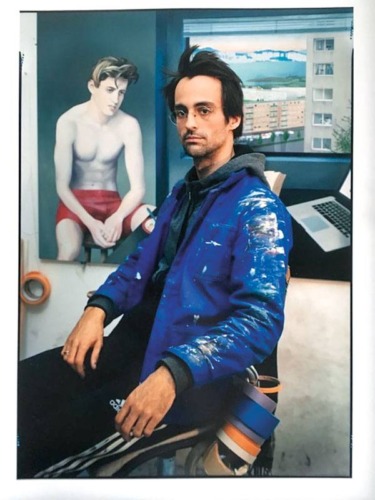Rising Art Star Jean Claracq Explores the Social Media Era with an Ancient Technique
Favoring the miniature, the Paris artist draws inspiration from Instagram, video games, and 14th-century Renaissance painters

The characters in Jean Claracq’s paintings are caught between the real world and the virtual, the past and the present. The young French artist has been causing a stir for his works that explore the human condition in the social media era while favoring a technique that is hundreds of years old: the miniature.
Some of Claracq’s hyper-detailed tableaux, crafted with oil paint on wood, measure slightly larger than a postage stamp. Blurring the lines between painting and photography, the smooth surfaces recall both glossy photo paper and the static brightness of a screen. “I have a very slow process, not only in the physical making of the work but also in the process of elaborating it,” says Claracq, who is inspired by 14th-centuy Flemish and Italian Renaissance painters like Robert Campin, Herri met de Bles, and Petrus Christus. “I get my inspiration from questions I have about the world. It can take months to compose a painting, and I can collect materials for an idea for years.”


His works depict boys on the cusp of adulthood in various states of alienation, boredom, and introspection, carefully staged within lush natural landscapes or the sterile architectural cityscapes often seen in video games. “I find photos everywhere—on the Internet, in newspapers, on the street,” says Claracq. “But for the past few years, I have been using models I find on Instagram. I am interested in using not only the form of a picture but also its context.”

Claracq’s work has been acquired by the fashion designer Agnès b. for her new art space. At Frieze London last fall, his Paris gallery, Galerie Sultana, sold out of his works—and the wait list is lengthy. This March, the Fondation Louis Vuitton gave him carte blanche for Open Space #7, its platform dedicated to emerging artists. For the occasion, he conceived “Propaganda,” five new works embedded in a large-scale architectural model.

In a period when people are spending hours online, his subject seems more resonant than ever. “During this time, I find it very difficult to be calm enough to think,” says Claracq. “Everything is upside down, and all the content on the Internet seems to be there to keep us busy not thinking.”

A version of this article first appeared in print in our 2020 Summer issue under the headline “Shape-Shifters.” Subscribe to the magazine.